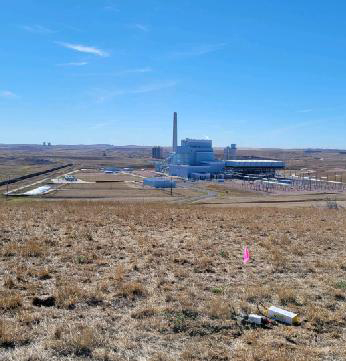
Researchers at School of Energy Resources Deploy Microseismic Sensors as Part of Ongoing Baseline Monitoring Operations for the Wyoming CarbonSAFE Project
Published November 12, 2021
By Christine Reed

Researchers at the UW School of Energy Resources’ (SER) Center for Economic Geology Research (CEGR) recently deployed a series of microseismic sensors as part of the ongoing baseline monitoring operations for the Wyoming CarbonSAFE Project.
Research scientists Charles Nye and Garret Gay traveled to Campbell County to assist the installation of 154 sensors around the project site located at Basin Electric Power Cooperative’s Dry Fork Station (DFS) and surrounding areas for the purpose of collecting data and determining the normal seismic activity for the area.
Supplied by Université Grenoble Alpes and installed and managed by Sisprobe, the surface geophones are designed to record data through triangulation and a beam-forming technology that provides the location of seismic events, how often the events occur, and any “signatures” of the event’s sound that are distinctive.
“Our goal is to collect data that will allow for the baseline characterization of the seismic activity in the region,” says Nye. “The data from these geophones will allow easy distinction between surface coal mine blasts, and deep natural seismic events.”
Phase III of the Wyoming CarbonSAFE Project was launched in October of 2020, with the objectives of finalizing the site characterization, permitting, integrating Membrane Technology and Research, Inc.’s (MTR) CO2 capture assessment, and conducting the National Environmental Policy Act (NEPA) analyses to advance towards the eventual commercialization of a large-scale carbon capture, utilization and storage (CCUS) project at Dry Fork Station.
“Knowing what the natural seismic is like is important so CEGR can ensure that if CO2 were later injected at this site, that injection does not cause any seismicity significantly bigger than what naturally occurs at the site,” says Nye. “Seismic activity is naturally occurring all over the earth, so rather than asking ‘did seismic events occur?’ we are ensuring we will have the data to determine if any occurrences are caused by human activity.”
According to Nye, the geophones used have a minimal footprint and consist of a sensor which is spiked into the ground, a data recorder which digitizes and time-stamps data, and a battery to boost the life-span of the system. They use timing information from the GPS satellite network to synchronize their data and efficiently monitor the network area.
CEGR is projected to drill a second well (PRB#2) in the coming months to a depth of about 10,000 feet below the surface. The two well system will use a water injection plan designed to calibrate fluid flow rates and paths in the CO2 target formations. The data collected from these tests will be used to finalize the geologic characterization for the study site.
“When fluids flow underground, they make noise, analogous to the sound of water flowing through pipes in a house. The geophone network will help CEGR determine rate and direction of the injected fluid between these wells, and how far the pressure which moved the water radiated from the injection test well,” says Nye. “The details of the sound made by this injection will be different from natural seismic background noise, and the geophones will let us confidently distinguish between these two kinds of sounds in the future.”
The microsesimic monitoring system is scheduled to remain in place for a few months and be removed as soon as the well test is complete.
Led by Nye, other baseline monitoring systems have also been installed in and around the area. Earlier in 2021, Nye installed a soil gas monitoring system that collects data hourly and remotely transmits the readings directly to scientists at UW to analyze and monitor. A monitor was even installed outside the UW Extension office to serve as a control.
“CEGR is proud to be leading a comprehensive monitoring system to support future development of the site,” says Fred McLaughlin, Interim Director of CEGR. “Establishing baselines for seismic, water, gas, and other components of the natural system in advance of any actual CO2 injection is an important part of understanding the impacts of CCUS.”
